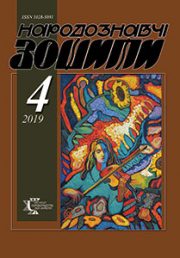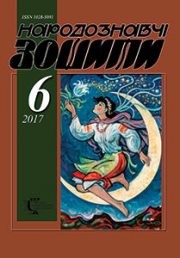The Ethnology Notebooks. 2024. № 2 (176), 390—397
UDK 2-526.62:159.935]069.4/.5-048.67
DOI https://doi.org/10.15407/nz2024.02.390
TACTILE ICONOGRAPHY — PRACTICAL APPLICATION IN THE POPULARIZATION OF MUSEUM COLLECTIONS
BABII Nadiia
- ORCID ID: https://orcid.org/0000-0002-9572-791X
- PhD in Art Studies, Associate Professor,
- Vasyl Stefanyk Precarpathian National University,
- 57, Shevchenka St., 76000, Ivano-Frankivsk, Ukraine,
- Contacts: e-mail: nadiia.babii@pnu.edu.ua
Abstract. The publication is a part of the program work of the Center for Research on Universal Design Strategies at Vasyl Stefanyk Precarpathian National University.
The subject of the study is tiflographic iconography, a type of specialized tactile graphics based on painted iconography dedicated to visually impaired people. The cognitive and aesthetic functions of tiflograms are analyzed. The interdependence of the original icon «The Coronation of the Virgin» and the tiflogram work are described on the basis of functionality and representation. On the basis of the experience gained, the source base, consultations with tiflography specialists, museum workers, and direct users of the practice, the level of adaptation of the visual work to the possibilities of understanding by a blind person is determined. The aim of the publication is to present the specifics of this type of graphics in a museum exposition. The relevance of the study is determined by the importance of overcoming the problems of visiocentricity of museum complexes and planning their accessibility for people with blindness. The scientific methods of art historical and design analysis were applied.
Conclusions. The result of the study was the practical creation of a collection of five icons and its representation in the exhibition project «Seeing Treasures Together!». The study proves the wide utility and social value of tactile iconography and the priorities for its further development in the following areas: accessibility of museum and exhibition spaces; general educational sphere; special tourism; and souvenir design. The further development and popularization of artwork tiflograms will help to ensure accessibility of art for the visually impaired and can be seen as an effective tool for shaping a proper attitude towards disability.
The rules for «editing» a teflogram is an important condition for the reliable transmission of cognitive information, as well as a means of ensuring the comfort and interest of users. In the theoretical plane, we have proved the effectiveness of compensatory technologies for the acquisition of aesthetic experience by blind people. The key point of departure for this discourse was the aesthetic experiences of the recipients and the ability to evoke them through works of iconography
and the environment, which was the museum space.
Keywords: iconography, tiflography, visual impairment, accessibility, museum space, universal design.
Received 6.03.2024
REFERENSES
- (2015). Ministry of Culture of Ukraine. Participation of persons with disabilities in cultural life, leisure and recreation: National report. Kyiv [in Ukrainian].
- Demchuk,А. (2014). Basic receptions and methods of typhlocomments. Bulletin of Lviv Polytechnic National University Information Systems and Networks, 783, 329—335 [in Ukrainian].
- Hulevych, S. (2021). The Tactile Book with Relief and Graphic Illustrations: The Features of Forming an Artistic Image and Transmitting Information to Children with Visual Impairments. Bulletin of the Lviv National Academy of Arts, 46, 123—128 [in Ukrainian].
- Christidou, D., & Pierroux, P. (2018). Art, touch and meaning making: an analysis of multisensory interpretation in the museum. Museum Management and Curatorship, 34 (2), 1—20. DOI:10.1080/09647775.2018.1516561.
- Svankmajer, J., & Dalby, S. (2014). Touching and Imagining. An Introduction to Tactile Art.
- Martillano, D.A. (2019). The Perceived Aesthetic Experience in the Context of Tactile Art among Visually Impaired Individuals in The Philippines. RSU International Research Conference. Pp. 543—553. Retrieved from: https://www.researchgate.net/publication/338865623_The_Perceived_Aesthetic_Experience_in_the_context_of_Tactile_Art_among_Visually_Impaired_Individuals_in_The_Philippines.
- Wieckowski, R. (2014). Audio description of beauty. Przekіac, 28, 109—123 [in Polish].
- Wieckowska, E. (2012). Polish school of typhlography. Disability, 7, 55—80 [in Polish].
- Stasenko, V. (2003). Christ and the Mother of God on woodcuts of Cyrillic books of Galicia of the 17th century. Kyiv: Polihrafknyha [in Ukrainian].
- Knapek, A. (2021). A museum at your fingertips. Contemporary Culture, 3 (115), 39—50. Doi.org/10.26112/kw. 2021.115.04 [in Polish].
- Romanska, O. (2024, 14.01). See by touch. How blind people are involved in art at Prekarpathian University. Reporter. Retrieved from: https://report.if.ua/statti/pobachyty-dotykom-yak-u-prykarpatskomu-universyteti-doluchayut-nezryachyh-lyudej-do-mystectva/?fbclid=IwAR00qOVFYLFuhUAotqGVh9Ksma3xvo_JuiI2mzSUBXXSz3ep6osEBeFmCTg [in Ukrainian].







